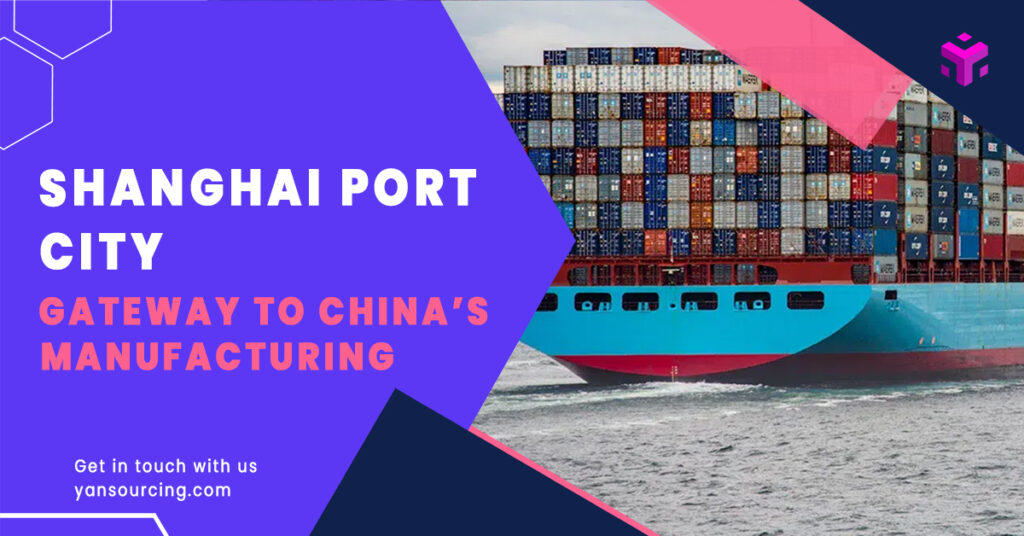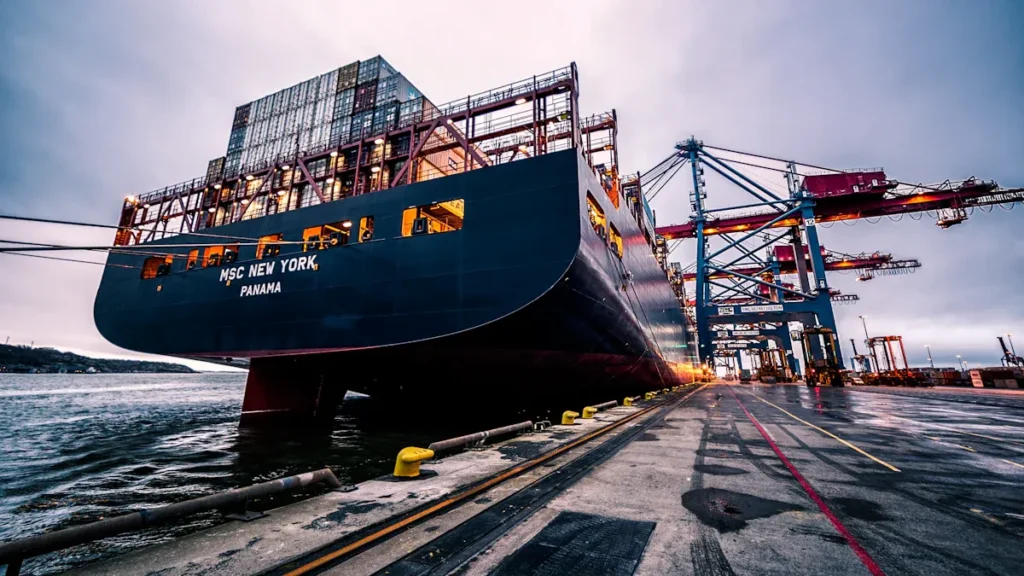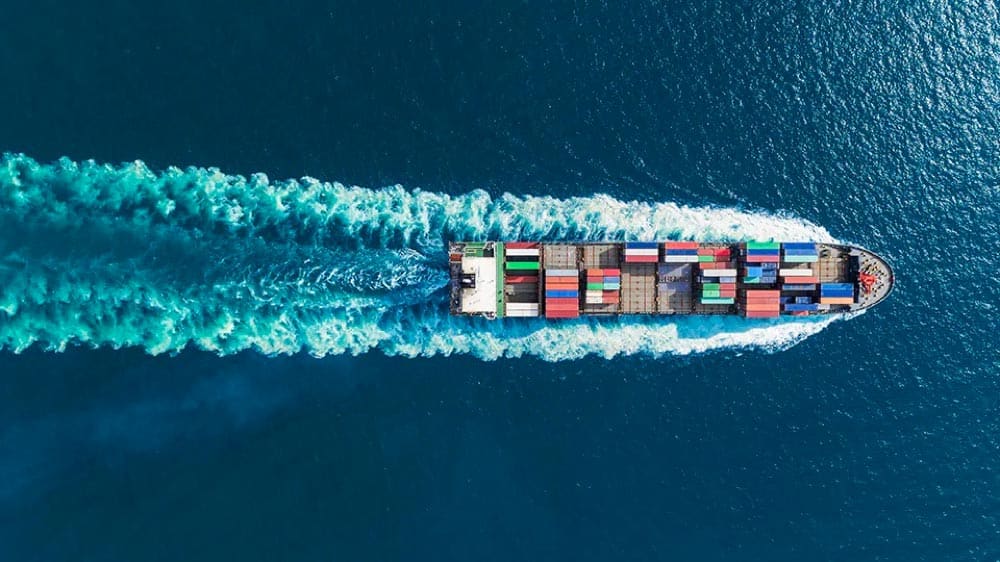
Shanghai Port City is a key part of global trade. It links China’s factories to the rest of the world. In 2023, it handled over 43 million TEUs. This makes it the busiest container port for 12 years. The port is very important for moving goods worldwide. China makes 28% of the world’s products, and Shanghai Port helps this happen. Its location and modern shipping systems are crucial. The port supports sea trade and helps the economy grow.
Key Takeaways
Shanghai Port City is the busiest container port worldwide. It handles over 43 million TEUs every year, supporting global trade.
Its location near China’s factories helps ship goods quickly and cheaply.
Smart tools like AI and robots make the port 40% faster and cut worker needs by 60%.
The port links to over 600 ports in 200+ countries, making trade easy between Asia, Europe, and the Americas.
Shanghai Port boosts China’s economy, adding 15% to nearby GDP and creating millions of jobs.
Plans for the port include growing its size and using green technology for eco-friendly progress.
Companies can use Yansourcing to make shipping easier and ensure fast, quality deliveries through Shanghai Port.
Shanghai Port uses clean energy and smart systems, leading the way in future global trade.
Strategic Importance of Shanghai Port City
Geographical Advantages of Shanghai
Close to China’s manufacturing areas
Shanghai is in the center of China’s factory zones. It is near productive regions like Jiangsu and Zhejiang provinces. These places make electronics, clothes, and machines. Being close to these factories helps goods move fast to the port. This saves time and lowers costs for shipping. Shanghai Port is a key part of global trade for industries like electronics and machinery.
Why this is important:
Goods from nearby factories reach the port in hours.
Faster shipping means quicker delivery to other countries.
This connection between factories and shipping makes Shanghai China’s gateway to the world.
Easy access to global shipping routes
Shanghai Port is on the Yangtze River Delta. This location connects it to major shipping routes worldwide. It links Asia to Europe, the Americas, and other continents. This makes Shanghai important for global trade.
Yangshan Deep-Water Port, part of Shanghai Port, is very advanced. It uses 5G technology and self-driving trucks to move goods. These tools make work faster and need fewer workers. Efficiency has improved by 40%, and staff needs dropped by 60%. This keeps goods moving smoothly around the world.
Historical Growth of Shanghai Port
From a small port to a global trade hub
Shanghai started as a small port in the 19th century. It mainly traded tea, silk, and ceramics. Its location and better infrastructure helped it grow into a big trade center.
By the late 20th century, Shanghai became the busiest container port globally. This growth came from investments in technology, infrastructure, and trade-friendly policies. Today, it handles over 43 million TEUs yearly, making it vital for global trade.
Role in China’s economic changes and globalization
Shanghai led China’s economic reforms in the late 20th century. The Shanghai Free Trade Zone (FTZ) was a big step. It brought tariff-free zones and simpler rules, helping businesses trade easily.
Here’s how these changes helped Shanghai:
Reform Description | Impact on Economy |
|---|---|
Creation of the Shanghai FTZ to open up trade | Made trade and investment easier, boosting the economy |
Simpler rules and tariff-free zones | Lowered costs and removed trade barriers |
New rules for foreign investment | Attracted foreign businesses and grew the service sector |
These changes didn’t just help Shanghai. They connected the port to global trade and showed China’s push for globalization.
Advanced Infrastructure and Technology at Shanghai Port
Shanghai Port is not just big; it’s very advanced. Its modern systems and tools make it a leader in port operations.
Specialized Terminals at Shanghai Port
Container terminals and their capacity
Shanghai Port has some of the best container terminals. These terminals have over 13 kilometers of docks, 43 berths, and 156 cranes. They handle huge amounts of cargo daily. Yangshan Deep-Water Port, part of the port, processes 2.2 million TEUs yearly. Shanghai Port is the busiest container port, managing 47 million TEUs and 800 million tons of goods each year.
This large capacity helps goods move fast and efficiently. From electronics to clothes, the port handles all kinds of products.
Bulk cargo and liquid terminals
Shanghai Port also manages bulk and liquid goods well. It has two bulk cargo terminals and three break-bulk terminals. These are in Luojing, Wusong, and Longwu areas. They handle raw materials like coal and liquids like oil and chemicals.
This makes Shanghai Port a reliable place for shipping all types of goods.
Automation and Smart Port Technologies
Use of AI and robotics in port operations
Shanghai Port uses smart machines to work better. Yangshan Deep-Water Port is automated with AI and robots. Self-driving trucks and cranes load and unload cargo precisely.
This technology speeds up work and lowers labor needs. It has improved efficiency by 40% and reduced staff by 60%.
Digital platforms for efficient logistics management
Running a big port like Shanghai needs smart tools. Digital systems help manage goods across terminals and warehouses. These systems use live data to plan routes and avoid delays.
This means faster deliveries and fewer problems for businesses.
Connectivity and Logistics Network
Integration with rail, road, and air transport
Shanghai Port connects to rail, road, and air networks. This makes moving goods across China and other countries easier. Rail-linked dry ports and smart layouts improve sea-rail transport.
This setup cuts costs and helps the environment by reducing pollution.
Role in the Belt and Road Initiative
Shanghai Port is key to China’s Belt and Road Initiative (BRI). This project connects Asia, Europe, and Africa for better trade. The port’s advanced systems make it a strong part of this plan.
For businesses, this means new markets and growth chances.
Shanghai Port City’s Role in Global Trade

Major Shipping Routes and Trade Partners
Key routes connecting Asia, Europe, and the Americas
Shanghai Port links Asia to the world. It connects over 600 ports in 200+ countries. This network helps goods move easily between continents.
Some main shipping routes from Shanghai are:
China to the USA: Los Angeles, Long Beach, New York.
China to Europe: Rotterdam, Hamburg, Antwerp.
China to the Middle East: Dubai, Jebel Ali, Dammam.
China to Africa: Durban, Lagos, Mombasa.
China to Southeast Asia: Singapore, Jakarta, Ho Chi Minh City.
The port has deep-water terminals for large ships. This makes shipping faster and keeps Shanghai a top global port.
Destination | Estimated Transit Time |
|---|---|
Los Angeles, USA | 12–18 days |
Hamburg, Germany | 30–35 days |
Dubai, UAE | 18–25 days |
Lagos, Nigeria | 40–50 days |
Melbourne, Australia | 20–25 days |
Top trading partners and export-import statistics
Shanghai Port connects China to big trade partners like the USA, Germany, and Japan. It handles 47 million TEUs yearly, staying the busiest container port since 2010.
The port exports electronics, machines, and clothes. It imports oil, chemicals, and raw materials. This makes it very important for global trade.
Economic Impact of Shanghai Port
Contribution to China’s GDP and employment
Shanghai Port helps China’s economy grow. It adds 15% to the GDP of nearby areas. It also boosts services like trade and logistics by 20%.
The port creates millions of jobs for workers and managers. These jobs support families and help Shanghai’s economy grow.
Influence on global supply chains and trade flows
Shanghai Port is key to global supply chains. It moves goods quickly and reliably. This attracts businesses and makes Shanghai a top trade hub.
The port connects Asia, Europe, and the Americas. It ensures products reach markets on time. This helps global trade and supports economies worldwide.
Future Plans and New Ideas at Shanghai Port
Shanghai Port is not just about today. It’s also planning for tomorrow. With big ideas, new technology, and care for the planet, the port is changing global trade.
Growing Shanghai Port
Plans to make the port bigger
Shanghai Port is getting ready for more business. To meet demand, it’s spending billions to grow. These projects will add space and make work faster.
Here’s what’s coming:
Project Name | Cost | New Capacity (TEU) | Finish Date |
|---|---|---|---|
New terminal area | 11.6 million | By the end of the 2020s | |
Luojing Container Terminal | N/A | 2.6 million | Phase I starts Aug 2024 |
Automated Luojing Terminal | N/A | 2.6 million | Phase I done |
These changes will help Shanghai Port handle even more goods.
Building smarter terminals
The port isn’t just getting bigger; it’s getting smarter. New terminals will use robots and eco-friendly designs. For example, Luojing Terminal will have automated systems to work faster. These updates will keep Shanghai Port a leader in global trade.
New Technology at Shanghai Port
Using green energy and eco-friendly tools
Shanghai Port is leading in green shipping. It uses electric trucks and renewable energy. A company called Westwell made the Q-Truck®, a self-driving electric truck. This truck cuts carbon pollution by 50 tons a year.
Westwell’s plan, Ainergy, mixes AI with clean energy. This makes the port greener and more productive.
Smarter logistics with AI
AI is changing how Shanghai Port works. Since 2017, AI has made the port safer and faster. Robots, self-driving trucks, and smart tools are used daily. These tools stop delays and make work smoother.
Imagine machines doing most of the hard work. That’s the future of Shanghai Port.
Caring for the Environment
Cutting carbon pollution
Shanghai Port is working hard to lower pollution. It uses electric vehicles, clean energy, and better emission controls.
Title | Authors | Summary |
|---|---|---|
Port-Related Emissions, Environmental Impacts and Their Implication on Green Traffic Policy in Shanghai | Yuyan Zhou et al. | Talks about pollution and green traffic ideas for Shanghai Port. |
Toward sustainable port development: an empirical analysis of China’s port industry using an ESG framework | N/A | Explains how Shanghai Port is becoming greener with low-carbon technology. |
These steps help the port stay green and efficient.
Growing while protecting the planet
Growing and staying eco-friendly is tough, but Shanghai Port is doing it. New terminals are built with green designs. The port also invests in clean technology. This way, the port grows without harming the planet.
By focusing on the environment, Shanghai Port is leading the way for other ports.
Challenges and Opportunities for Shanghai Port City

Congestion and Capacity Issues
How growing trade affects port efficiency
Shanghai Port is one of the busiest in the world. It handles millions of containers every year. But being busy brings problems too. As trade grows, the port faces congestion. In April 2022, ships going to Ningbo took 27% longer than before. Ships from Taiwan, South Korea, and Japan also had big delays of 48%, 38%, and 32%.
The time ships spent at the port went up by 26%. This added nearly 5,000 extra hours in April 2022. These delays slow down supply chains. Goods take longer to reach their destinations.
Fixing delays and congestion
Shanghai Port is working to solve these problems. It’s using smarter systems and better tools. Self-driving trucks and AI cranes help load and unload faster. The port is also building new terminals like Luojing to handle more goods.
Another way to fix delays is by improving transport links. Better rail and road connections help move goods faster. These changes reduce congestion and make the port more efficient.
Environmental Concerns at Shanghai Port
Pollution from port activities
Shanghai Port’s busy operations cause pollution. Ships, trucks, and machines release carbon emissions. This harms air quality and marine life. A study called “Shanghai Port Carbon Emission Study” shows how port activities affect the environment.
Steps to reduce pollution
To fight pollution, Shanghai Port is going green. It uses electric trucks and renewable energy. The port also follows strict rules to cut emissions. These efforts protect the environment and set an example for other ports.
Global Trade Dynamics and Shanghai Port
Dealing with trade problems and uncertainties
Global trade is always changing, and this affects Shanghai Port. Trade fights between big countries can cause problems. Tariffs and restrictions can slow down trade. But Shanghai Port’s location and advanced systems help it stay strong.
New chances in growing markets
There are also good opportunities for Shanghai Port. New trade deals and growing markets bring new chances. China’s Belt and Road project connects Shanghai to Asia, Europe, and Africa. This helps the port grow and reach more places. For businesses, this means more markets and chances to grow.
Yansourcing and Shanghai Port City: A Smart Team-Up
How Yansourcing Uses Shanghai Port
Helping businesses with sourcing and shipping
If you need products from China, Yansourcing is here to help. They use Shanghai Port to move goods quickly worldwide. The port’s location and modern systems make shipping smooth.
Yansourcing handles everything for you. They find good suppliers and manage shipping. You won’t face delays or extra costs. Their team ensures your goods arrive on time and within budget. Whether you’re new or experienced, Yansourcing makes global trade easy.
Skilled in Shanghai’s trade system
Shanghai’s trade system can be tricky to navigate. But Yansourcing knows it well after years of experience. They have strong ties with suppliers and shipping companies.
Their team gets the best deals and checks product quality. They also handle challenges like language and cultural differences. With Yansourcing, the process becomes simple and stress-free.
Building Materials and Shanghai Port
Sourcing building materials through Shanghai Port
Need building materials? Yansourcing can help. They find items like furniture, lights, and marble through Shanghai Port. The port’s size and technology make it great for these goods.
Yansourcing works with trusted suppliers to meet your needs. They use the port’s fast shipping system to save time and money. Whether you want ready-made items or custom designs, Yansourcing delivers.
Ensuring quality and on-time delivery
Good quality and quick delivery are very important. Yansourcing knows this and checks every product carefully before shipping.
Shanghai Port’s advanced tools handle goods safely. Yansourcing also keeps you updated during the process. With their help and the port’s systems, your materials will arrive on time and in great shape.
Conclusion
Shanghai Port City is a key hub for trade and factories. It helps China’s economy grow by creating jobs and boosting industries. The port connects countries and supports the global economy, making it very important in shipping.
In the future, Shanghai Port will focus on green energy and smart tools. These changes will keep it a leader in global trade. Businesses will enjoy faster shipping, better systems, and more chances to grow.
Yansourcing helps businesses use Shanghai Port’s benefits. They are experts in finding products and managing shipping. Whether you need building materials or other goods, Yansourcing makes everything easy and dependable.
FAQ
1. Why is Shanghai Port the busiest in the world?
Shanghai Port moves over 43 million TEUs every year. It is close to factories and major shipping routes. Smart technology and fast systems make it very efficient.
2. How does Yansourcing help with shipping through Shanghai Port?
Yansourcing makes shipping easy by finding good suppliers. They handle logistics and use the port’s advanced tools. This saves time and money for businesses.
3. Can Yansourcing find custom building materials?
Yes! Yansourcing can get both ready-made and custom materials. They work with trusted suppliers to meet your needs, like furniture or marble.
4. Why is Shanghai Port important for world trade?
Shanghai Port links over 600 ports in 200 countries. It connects Asia to Europe, the Americas, and more. This makes it key for moving goods globally.
5. What goods are shipped through Shanghai Port?
Shanghai Port exports electronics, machines, and clothes. It imports oil, chemicals, and raw materials. These goods are vital for many industries.
6. How does Shanghai Port stay eco-friendly?
The port uses electric trucks and clean energy to cut pollution. It also invests in green tools like self-driving trucks to protect nature.
7. Is Yansourcing good for small businesses?
Yes! Yansourcing helps businesses of all sizes. They offer low order limits, fair prices, and personal support for small companies.
8. What are the benefits of using Yansourcing for shipping?
Yansourcing handles everything from picking suppliers to delivery. They check quality, get good deals, and keep you informed. This saves time and ensures smooth shipping.

